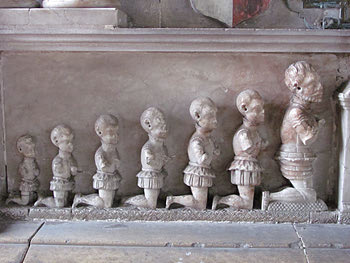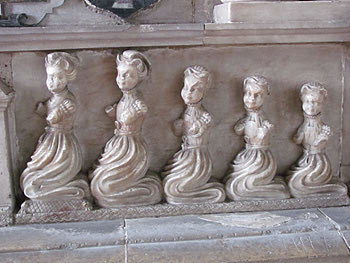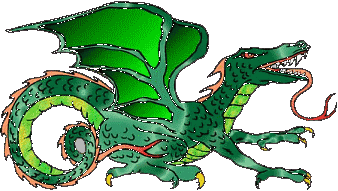|
|
This is a fine monument to Sir William
Waldegrave (died 1613), his wife Elizabethm and their ten children.
On the front of the memorial you
will observe twelve small effigies but strangely enough none to
remember William, the deceased.
All the arms of the twelve figures
have been sheared off, presumably by a soldiers sword on the orders
of William Dowsing in 1643.(see notes below)
Records indicate Dowsing
visited Bures to carry out his work of destruction on February 23rd
1643
|
 Sir William Waldegrave(right) and
his six boys
Sir William Waldegrave(right) and
his six boys |

Elizabeth Waldegrave(left) and the four girls
|
|
|
It is only when you look around the
back of the monument under the light of the window, can you find
the inscription.

|
|
|
To the left of the Waldegrave Monument
is a tomb chest with a slab, stripped of its brasses inclined on
the top, which is believed to be that of Sir George Waldegrave.
|
| Stained Glass window in
the Waldegraves Chapel |
|
Link
to Waldegrave Family Tree
 |
On a window ledge in the north aisle
is the very rare wooden effigy of a knight, complete with mail coat,
mail hose and knee cops, sword belt and part of sword, legs crossed
and feet spurred, with lion at his feet, and angels supporting the
cushion beneath his head.
The effigy is carved in sweet chestnut,
and dates from about 1330.
It is one of only two of that period
in Suffolk. Suffolk's only other wooden medieval effigy is across
the county at Heveningham.
Its identity cannot be proven as
there are no identification marks, but it is almost certain that
it represents Sir Richard De Cornard. This belief was current as
long ago as the 16th century, when the effigy was in the same position
under the window.
It is believed that the body is buried
beneath the north wall. At some period the effigy has been given
a coat of paint, presumably with the idea of preserving it, which
accounts for the polished appearance of the wood.
There are believed to be only three
wooden effigy`s in the entire country of such age.
|
NOTES:-
William Dowsing (1596–1668)
operated at the time of the English Civil War. Dowsing was a puritan soldier
who was born in Laxfield, Suffolk.
In 1643 he was appointed by their
Captain-General, the Earl of Manchester as "Commissioner for the
destruction of monuments of idolatry and superstition" to carry out
a Parliamentary Ordinance of the 28th of August 1643 which stated that
"all Monuments of Superstition and Idolatry should be removed and
abolished", specifying: "fixed altars, altar rails, chancel
steps, crucifixes, crosses, images of the Virgin Mary and pictures of
saints or superstitious inscriptions." In May 1644 the scope of the
Ordinance was widened to include representations of angels (a particular
obsession of Dowsing's), rood lofts, holy water stoups, and images in
stone, wood and glass and on plate.
Dowsing carried out his work in
1643-4 by visiting over 250 churches in Cambridgeshire and Suffolk, removing
or defacing items that he thought fitted the requirements outlined in
the Ordinance. He recruited assistants, apparently among his friends and
family, and where they were unable to perform the work themselves he left
instructions for the work to be carried out. Sometimes the local inhabitants
assisted his work, but often he was met by resistance or non-co-operation.
His commission, backed up by the ability to call on military force if
necessary, meant that he usually got his way. He charged each church a
noble (a third of a pound:- 33p) for his services.
Extracts from Dowsing own notes:-
Feb. 23. At Mr. [Capt.] Watgraves [Waldegrave’s]
chappel, in Buers [Smallbridge Hall chapel, Bures St Mary], there was a
picture of God the Father, and divers other superstitious pictures, 20 at
least, which they promised to break, his daughter and servants. He himself
was not at home, neither could they find the key of the chappell. I had
not the 6s. 8d. yet promised it. And gave order to take down a cross.
Buers [Bures St Mary], Feb. 23. We brake
down above 600 superstitious pictures, 8 Holy Ghosts, 3 of God the Father,
and 3 of the Son. We took up 5 superstitious of Quorum animabus propitietur
deus; one Pray for the soul. And superstitious in the windows, and some
divers of the apostles.
Text Courtesy of St Mary`s Church booklet
Additional information by Rebecca Fraser, Historical Researcher and Author
Alan
Beales ver1 06/04/10
|

